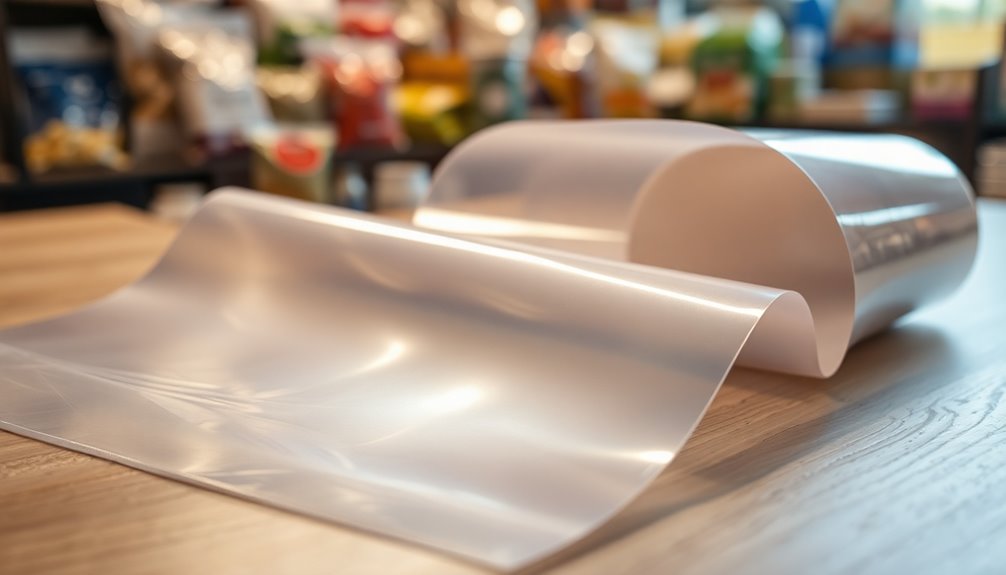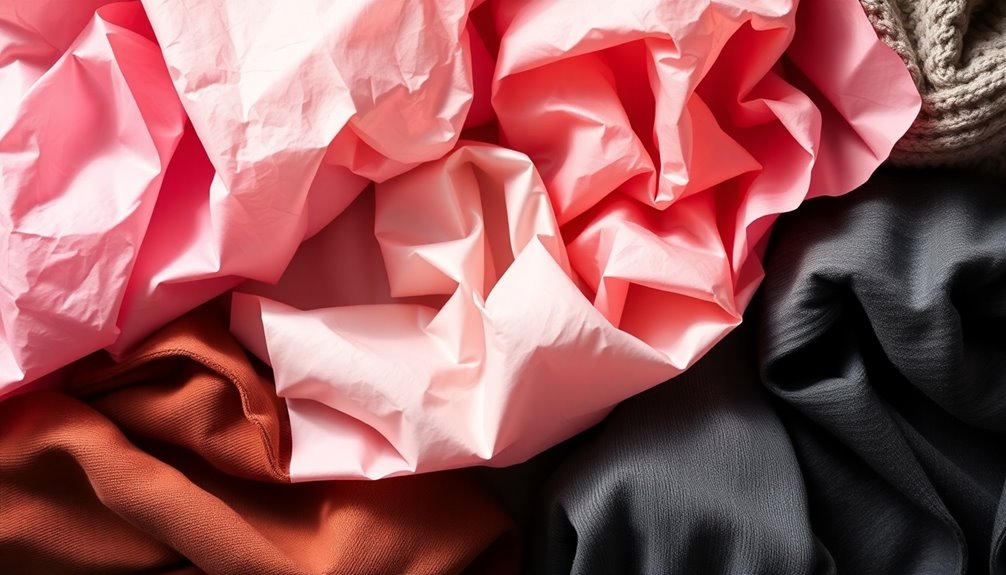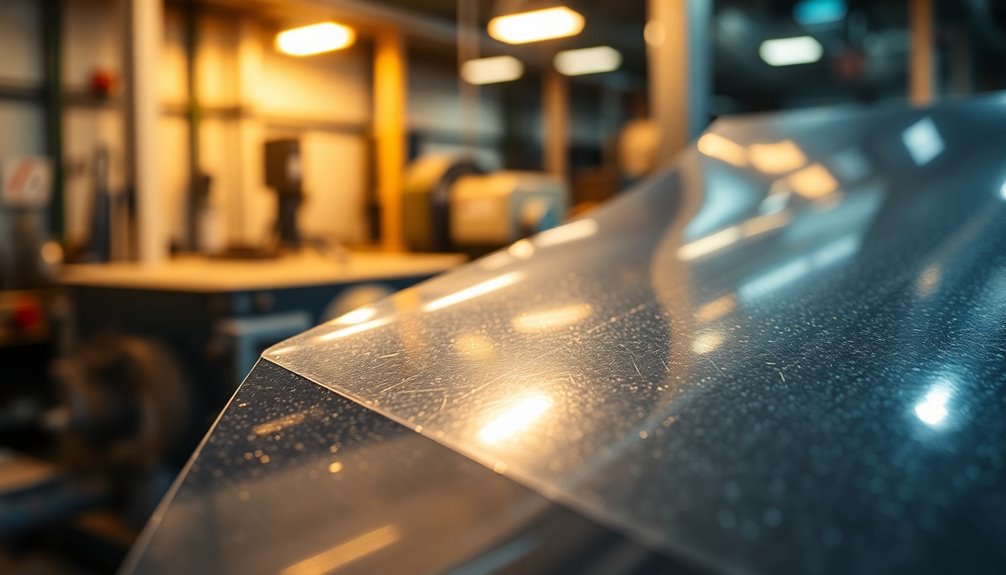PE film needs to achieve multiple critical functions to protect, preserve, and enhance product quality. You'll find it excels in shielding goods from moisture, dust, and impact, which is vital in food packaging to extend shelf life. It also provides essential durability in construction and industrial applications, acting as a protective barrier against UV rays and moisture. Moreover, in agriculture, PE film helps retain soil moisture and improves crop yields. Its versatility makes it a go-to solution across sectors, ensuring products stay safe and sound. Discover how these functions play a larger role across various applications.
Key Takeaways
- PE film must provide moisture resistance to extend the shelf life of food products and prevent spoilage.
- It needs to offer protective qualities against dust, physical impact, and electrostatic discharge for sensitive items.
- The film should ensure durability and tensile strength to withstand tearing and punctures in heavy-duty applications.
- It must facilitate agricultural functions like weed growth prevention and moisture retention to enhance crop yields.
- PE film should contribute to cost-effectiveness in packaging and logistics while addressing environmental concerns through sustainable options.
Overview of PE Film Functions
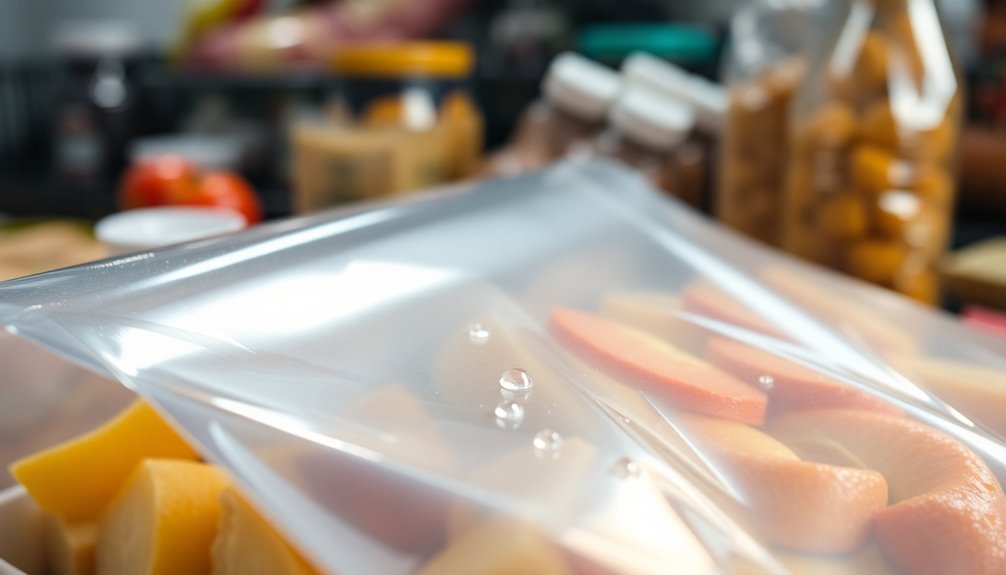
PE film frequently serves multiple essential functions across various industries. It's primarily known for its protective qualities, shielding your products from moisture, dust, and physical impact. This barrier helps maintain product quality by preventing environmental elements from causing damage. Notably, the film's moisture resistance plays a vital role in food packaging applications, where it extends shelf life by preventing spoilage.
In construction, you might find it used as vapor retarders or for safeguarding flooring and countertops.
Durability is another critical aspect. High-density polyethylene (HDPE) and blown PE films boast excellent resistance to tears and punctures, making them ideal for heavy-duty applications such as industrial bags.
With superior tensile strength, linear low-density polyethylene (LLDPE) films can absorb sudden forces without tearing, ensuring reliability in challenging conditions.
Versatility and flexibility also set PE film apart. Available in various forms like LDPE, LLDPE, and HDPE, it adapts to different needs through processes like blown film extrusion.
You can use it to protect sensitive automotive parts or in applications that require both strength and flexibility, such as carrier bags.
Additionally, specialized functionalities like anti-static and anti-fog features enhance its usability, making PE film crucial across a range of applications.
Packaging and Wrapping Applications
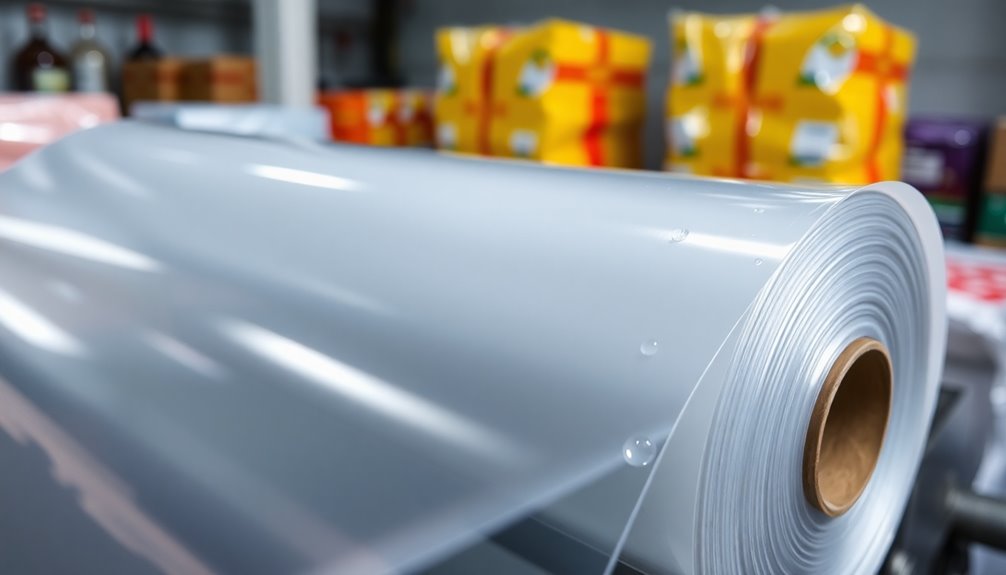
Packaging and wrapping applications leverage the unique properties of polyethylene to ensure products remain safe and fresh. In food and beverage packaging, polyethylene offers moisture resistance, keeping items like fresh fruits and frozen goods protected. You'll find HDPE in milk containers and LDPE in squeezable bottles, showcasing its versatility. Additionally, with over 6800 grades of polyethylene available, manufacturers can select the most suitable type for their specific packaging needs.
In medical and pharmaceutical settings, polyethylene's hygienic properties make it ideal for packaging syringes and sterile wraps. Its contamination resistance ensures that these products remain safe for use, while precise engineering allows for child-resistant and tamper-evident packaging, enhancing consumer safety.
For consumer goods, polyethylene provides a lightweight yet sturdy solution, safeguarding items during transportation. Its economical nature also makes it a popular choice for packaging everything from toys to kitchenware. Plus, anti-static properties protect sensitive electronics from electrostatic discharge.
Lastly, polyethylene is widely used in general wrapping and labeling applications. It serves to manufacture labels and tags while protecting surfaces and machinery from damage. With film wraps, you can easily secure and package various items, showcasing polyethylene's adaptability across numerous industries.
Agricultural Benefits of PE Film
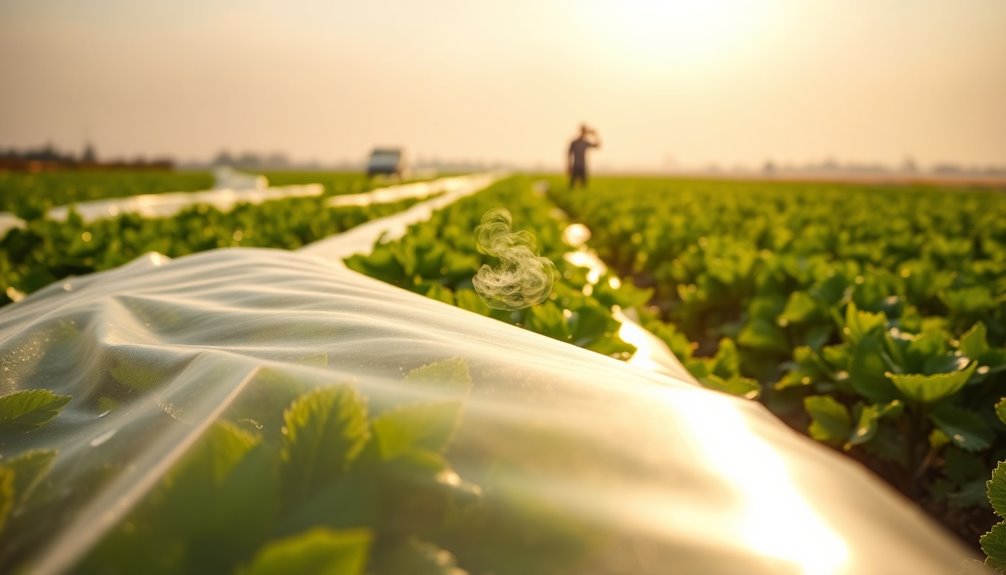
In the agricultural sector, polyethylene film offers a range of benefits that enhance farming practices and crop productivity. By blocking sunlight, it prevents weed growth, reducing your need for manual weeding or chemical herbicides. This helps maintain soil health, preserving topsoil from erosion caused by wind and water, while creating better conditions for plant growth.
PE film also excels in moisture retention and temperature regulation. It minimizes evaporation, conserving water resources and reducing the frequency of watering. By insulating the soil, it creates a greenhouse effect, stabilizing temperatures essential for seed germination and young plants. Additionally, temperature regulation ensures that crops can thrive even during fluctuating weather conditions, enhancing overall productivity.
Moreover, PE film aids in disease and pest reduction. Acting as a barrier, it lowers the incidence of soil-borne diseases, protecting your crops and minimizing reliance on pesticides. This not only promotes healthier plants but also prevents the spread of pests crucial for large-scale farming.
Finally, it enhances fertilizer efficiency. By reducing leaching, nutrients remain available in the soil, increasing crop yields and quality. This ensures you can achieve higher market prices while lowering environmental runoff, benefiting both your farm and the ecosystem.
Construction Industry Uses

The versatility of polyethylene film makes it an essential tool in the construction industry. You can use protective sheeting to contain dust and debris during painting or repair work, ensuring a cleaner workspace. It also protects flooring from water damage and keeps your tools and equipment clean and dry, preventing harmful particles from being inhaled by workers.
Polyethylene film is crucial for curing and vapor barriers as well. It retains moisture during concrete curing and blocks water vapor from the ground, which is vital for preventing moisture-related issues in buildings. This ensures you achieve proper curing conditions for your concrete projects. Additionally, its adaptability allows for easy installation across diverse surfaces and shapes, making it suitable for various applications in construction.
In form lining and tilt-up construction, polyethylene film enhances the strength and durability of forms, providing a smooth surface for concrete finishing. This not only contributes to structural integrity but also helps you achieve a uniform concrete texture.
Lastly, polyethylene film offers excellent weather and moisture protection. It acts as a construction wrap, preventing air infiltration and protecting materials from UV rays, rain, and temperature fluctuations. This durable and reusable protection is vital for maintaining the quality of your construction supplies.
Healthcare and Medical Functions
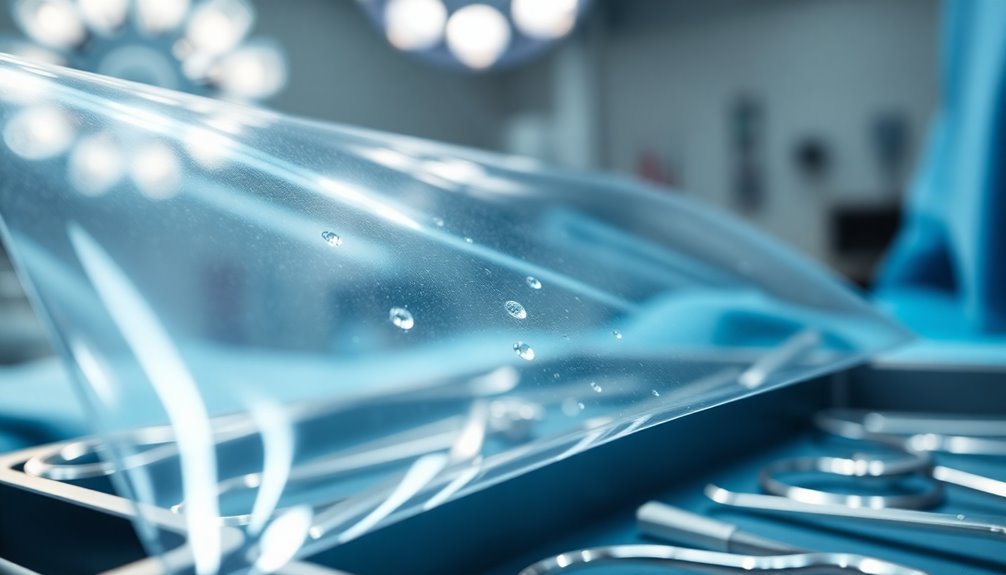
Polyethylene film plays a vital role in healthcare and medical functions, much like its applications in the construction industry. In medical settings, it's essential for packaging and sterilization. You'll find it used to package medical devices and supplies, ensuring they remain sterile until needed. This film creates a barrier against moisture, bacteria, and other contaminants, crucial for preventing infections and ensuring patient safety.
When it comes to surgical applications, polyethylene film is equally important. It's utilized in making drape sheets that cover patients and equipment, maintaining a sterile environment during procedures. It also serves as surgical incise film, safeguarding the surgical site from contamination. Additionally, its effective barrier properties help enhance the overall sterility in these situations.
Furthermore, polyethylene film is key in protective clothing and equipment. It provides a barrier against bodily fluids, protecting both healthcare workers and patients. You'll see it in gowns, gloves, and even as liners for medical trays.
Lastly, polyethylene film is vital for medical device and supply protection. It offers superior barrier properties for fluid bags, transdermal patches, and wound-care products, ensuring sterilization methods like gamma and ethylene oxide don't compromise their integrity.
Industrial and Chemical Applications
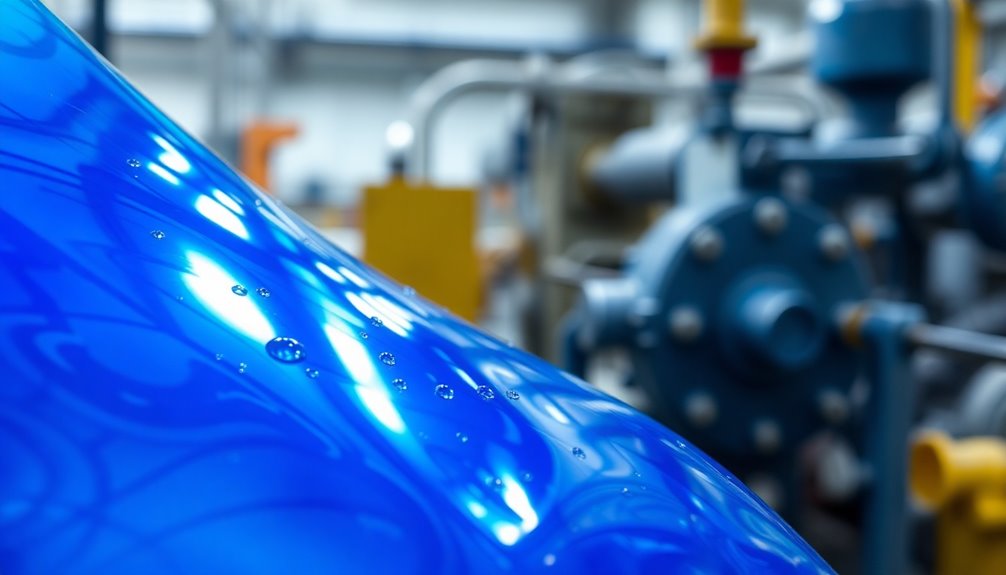
When it comes to industrial and chemical applications, polyethylene film proves to be incredibly versatile and effective. Its durability makes it the perfect choice for wrapping heavy or sharp-edged products, providing protection against tears and punctures. You can rely on it for pallet wrapping and protective covers for machinery, ensuring that your equipment stays safe during storage and shipping. Plus, its moisture resistance is crucial for safeguarding products from environmental factors.
Polyethylene film also excels in chemical resistance, suitable for handling hazardous substances. You can use it to wrap products that need protection from chemicals, while it simultaneously shields equipment and surfaces from potential damage during industrial processes. This film acts as a barrier against corrosive materials, enhancing safety across your operations, as it is made from polyethylene resin, which is known for its ability to withstand harsh chemical environments.
Additionally, polyethylene serves as protective sheeting during construction, preventing damage to surfaces. It can create temporary enclosures at job sites, keeping equipment and workers safe from environmental elements. Whether you're protecting machinery from dust or ensuring flooring and countertops remain intact, polyethylene film is an essential tool in your industrial and chemical applications.
Environmental Protection Roles
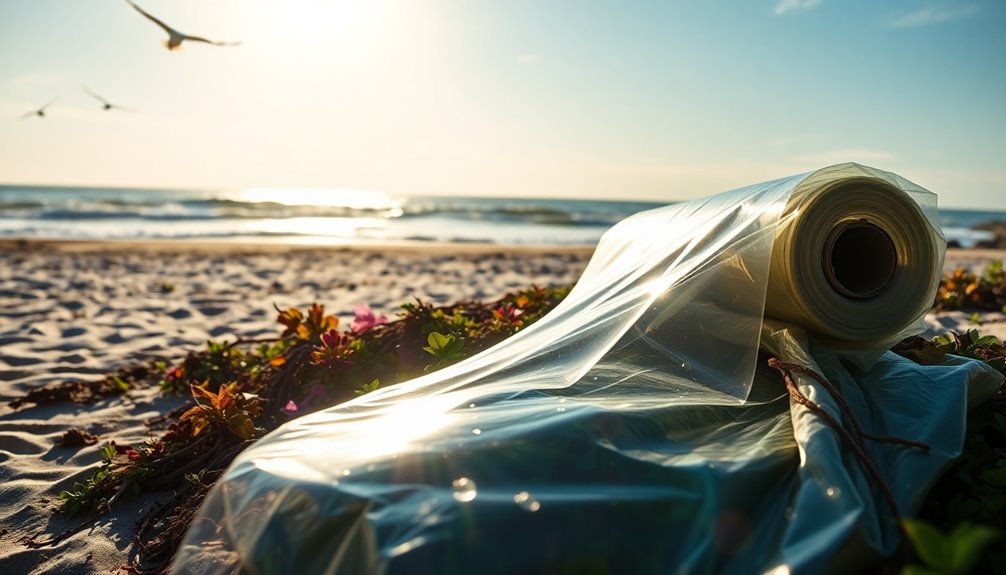
Environmental protection roles of polyethylene film are becoming increasingly critical as awareness of plastic pollution grows. While PE film is derived from non-renewable fossil fuels and can take hundreds of years to decompose, its environmental impact is significant. This film contributes to plastic waste and pollution, with large amounts ending up in oceans and ecosystems, threatening biodiversity. Microplastics generated through the breakdown of PE film can enter food chains, harming both flora and fauna.
Animals often mistake these microplastics for food, leading to serious health issues, while the slow decomposition rate exacerbates long-term environmental pollution. Although PE film is technically recyclable, challenges like contamination hinder effective recycling, resulting in only about 5% actually being processed. Additionally, the versatility of PE protection film in various industries highlights its widespread use, which can complicate efforts to reduce its environmental footprint.
To mitigate these issues, you can play a role by encouraging proper handling and recycling of PE waste. Support initiatives that develop bio-based and recyclable alternatives to traditional PE film. Stay informed about recycling programs specific to plastic films and educate others on the importance of reusing and recycling PE products. By taking these steps, you can help reduce the environmental burden associated with polyethylene film.
Moisture and Vapor Control
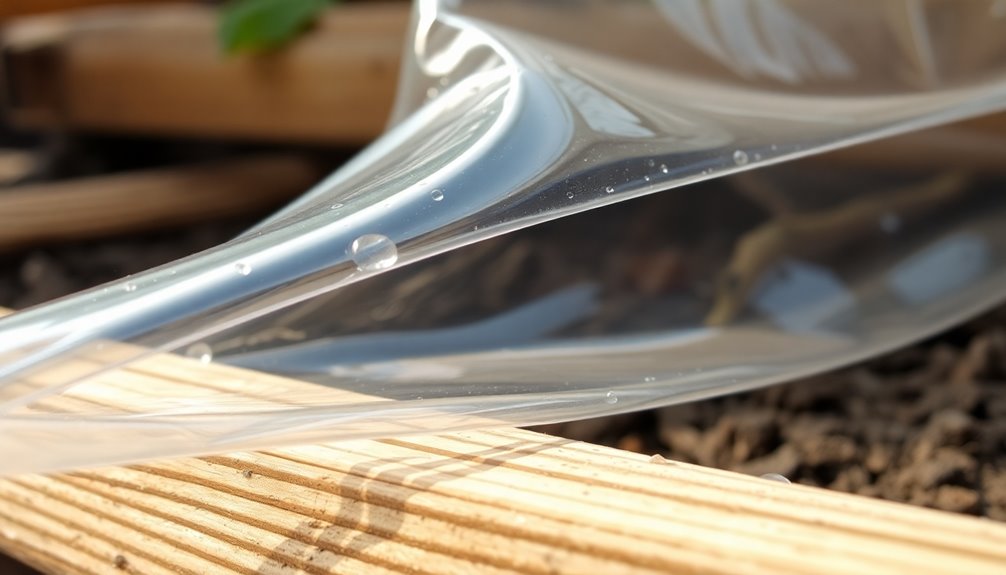
Moisture and vapor control is crucial for protecting various surfaces and materials, especially in flooring applications. Using polyethylene (PE) films, you can effectively create a moisture barrier that optimizes resin properties like density and melt index. Higher-density PE resins reduce water-vapor transmission rates, ensuring your flooring remains unaffected by moisture.
PE films establish a tortuous pathway that blocks moisture and vapor. The efficiency of vapor control is influenced by the film gauge and layer structure. Coextruded films, combining different resins, can further enhance performance.
For flooring, these films act as underlayment, safeguarding against moisture vapor from concrete subfloors, making them ideal for laminate, vinyl plank, and hardwood installations. The poly film flooring underlayment provides a reliable solution for moisture protection, ensuring long-lasting performance for your flooring.
You'll find that universal 6mil poly films are often common for this purpose, providing adequate moisture and vapor control. Easy installation features, like built-in lips and tape, ensure you can seal the edges effectively.
Remember that processing conditions, such as extrusion temperature and pressure, can also impact the barrier performance. By choosing the right PE film, you'll protect your flooring investment and maintain its integrity against moisture-related damage.
Cost-Effectiveness in Various Sectors
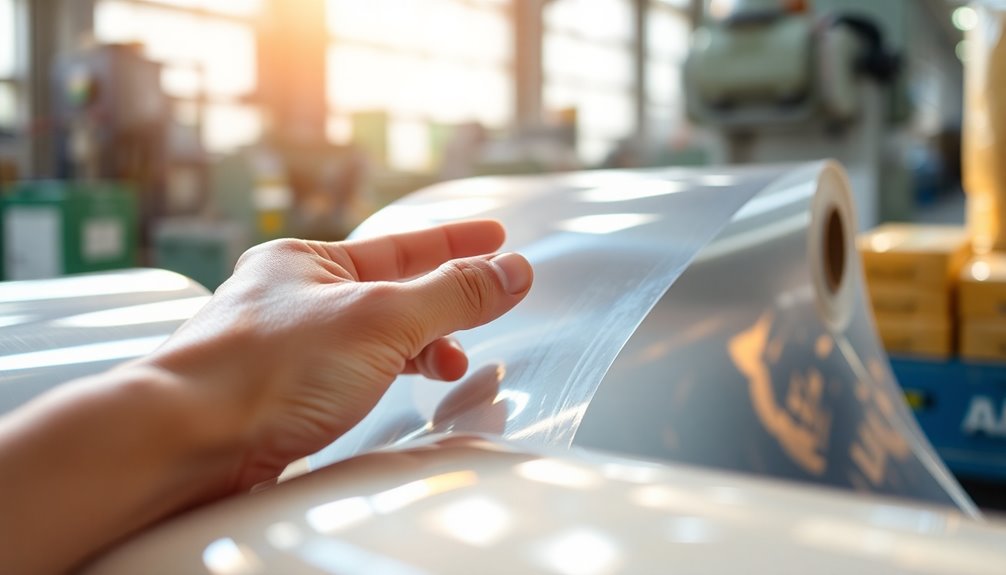
Recognizing the cost-effectiveness of polyethylene (PE) film across various sectors can significantly influence purchasing decisions.
In the packaging sector, you'll find PE film in everything from food packaging to carrier bags. Its versatility means it's ideal for items like freezer bags and cling wrap, providing a reliable solution for your packaging needs. The market for polyethylene film is essential for applications in food packaging, which is crucial for preserving food hygiene and safety against bacteria.
In agriculture, the rising consumption of PE film, particularly in China, demonstrates its value. With applications like mulch films and greenhouse covers, it helps improve crop yield while reducing costs.
In households, PE film is a go-to for cake liners, zipper bags, and disposable tablecloths. Its recyclability and biodegradability make it increasingly popular, offering cost-effective solutions for storage and cleaning tasks.
Lastly, in logistics and shipping, PE film protects items during transportation, minimizing damage and reducing the need for excessive packaging materials. Its durability ensures that your goods are safe, making it a smart choice for shipping solutions.
Future Trends in PE Film Usage
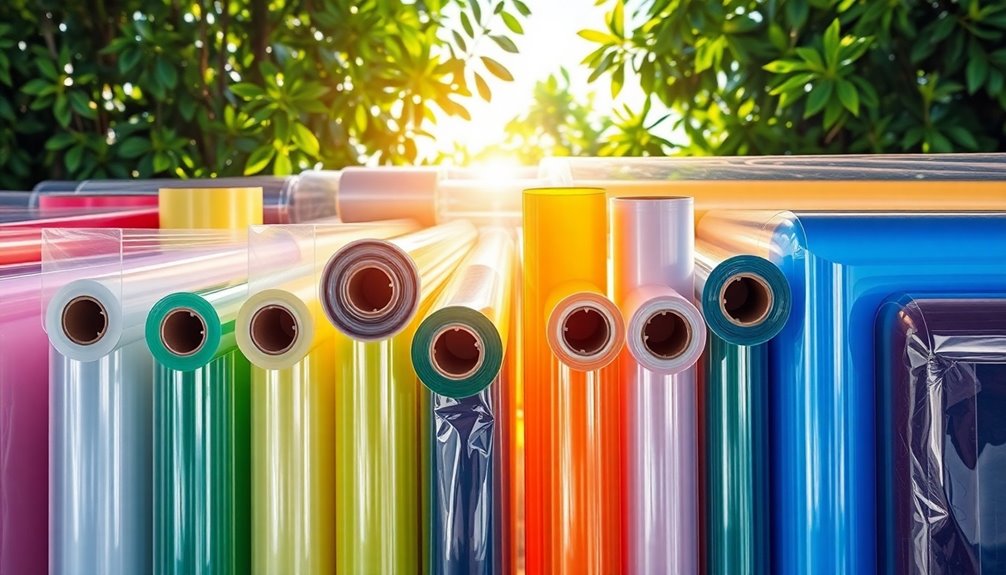
The future of polyethylene (PE) film usage is poised for transformation as industries adapt to evolving consumer demands and sustainability pressures. You can expect to see a surge in lightweight polyethylene film in e-commerce, driven by the need for frictionless delivery and reduced infection risks.
Companies like Amazon and Apple are already utilizing this trend, significantly increasing their PE film usage for packaging goods like food and cosmetics.
At the same time, there's a notable shift towards sustainable options. As consumers lean towards eco-friendly choices, biodegradable PE films made from renewable resources, such as sugarcane, are becoming more popular. Innovations in bimodal HDPE maintain the essential properties of traditional films while addressing environmental concerns.
In agriculture, PE films will continue to play a crucial role, particularly in enhancing crop yields and protecting plants.
Innovations like high-performance recycled LDPE and multi-layer films will improve efficiency and sustainability.
As manufacturers embrace these advancements and refine their processes, you'll witness a balance between functionality and environmental responsibility in PE film applications, paving the way for a more sustainable future.
Frequently Asked Questions
What Is the Environmental Impact of PE Film Production?
The environmental impact of polyethylene (PE) film production is significant.
You're looking at pollution from fossil fuel extraction and processing, which harms air and water quality. The production process emits greenhouse gases and generates waste that can end up in landfills, contributing to plastic pollution.
Additionally, PE film lasts for hundreds of years in the environment, threatening wildlife and disrupting ecosystems, with harmful chemicals potentially contaminating soil and water.
How Does PE Film Compare to Alternative Materials?
When you compare PE film to alternative materials, you'll notice its flexibility and softness stand out.
PE films conform easily to various shapes, making them great for packaging. While HDPE offers more durability and strength, it lacks the elasticity of PE.
Additionally, PE films are generally more cost-effective and environmentally efficient due to lower resource usage, though their recyclability can vary.
Is PE Film Recyclable or Biodegradable?
You might be wondering if PE film is recyclable or biodegradable.
Good news! PE film is recyclable in many municipalities, but you need to take it to specific drop-off bins. Just make sure it's clean and dry.
As for biodegradability, it doesn't break down easily, often taking decades. While some methods enhance its breakdown, controversy surrounds oxo-biodegradable claims.
What Are the Safety Concerns Related to PE Film Use?
When using PE film, you should be aware of several safety concerns.
Skin contact can lead to irritation or redness, while inhaling fumes may cause respiratory issues.
It's crucial to avoid overheating the film, as temperatures above 480°F can release toxic vapors.
Always wear protective gear and ensure good ventilation during processing.
If irritation occurs, flush your eyes with water and move to fresh air if symptoms persist.
Stay safe while handling!
How Is PE Film Manufactured and What Are the Processes Involved?
You start with selecting the right plastic pellets, which you feed into an extruder.
The pellets melt due to heat and are forced through a die to form a tube.
After inflating it with air, you cool the tube using rollers or air.
Once cooled, you collapse the tube into a flat film.
Finally, you wind the film onto rolls, readying it for additional processing or use in various applications.
Conclusion
In summary, PE film plays a crucial role across various sectors, from packaging and agriculture to construction and healthcare. Its ability to provide moisture control, cost-effectiveness, and environmental protection makes it an indispensable material. As you look to the future, keep an eye on emerging trends that could enhance its functionality and sustainability. Embracing these innovations will ensure PE film continues to meet your needs effectively while contributing to a more eco-friendly world.

